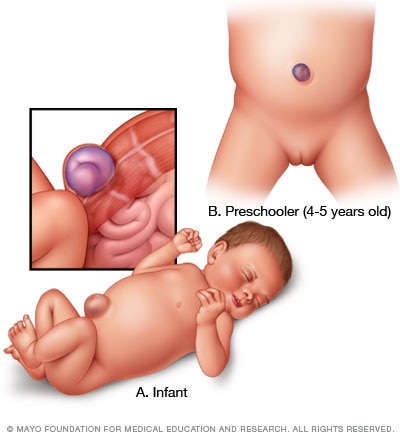Overview
An umbilical hernia occurs when part of your intestine bulges through the opening in your abdominal muscles near your bellybutton (navel). Umbilical hernias are common and typically harmless.

Umbilical hernia
An umbilical hernia creates a soft swelling or bulge near the navel. It occurs when part of the intestine protrudes through the umbilical opening in the abdominal muscles. Umbilical hernias in children are usually painless.
Umbilical hernias are most common in infants, but they can affect adults as well. In an infant, an umbilical hernia may be especially evident when the infant cries, causing the bellybutton to protrude. This is a classic sign of an umbilical hernia.
Children’s umbilical hernias often close on their own in the first two years of life, though some remain open into the fifth year or longer. Umbilical hernias that appear during adulthood are more likely to need surgical repair.
Symptoms
An umbilical hernia creates a soft swelling or bulge near the navel. In babies who have an umbilical hernia, the bulge may be visible only when they cry, cough or strain.
Umbilical hernias in children are usually painless. Umbilical hernias that appear during adulthood may cause abdominal discomfort.
When to see a doctor
If you suspect that your baby has an umbilical hernia, talk with the baby’s doctor. Seek emergency care if your baby has an umbilical hernia and:
- Appears to be in pain
- Begins to vomit
- Has tenderness, swelling or discoloration at the site of the hernia
Similar guidelines apply to adults. Talk with your doctor if you have a bulge near your navel. Seek emergency care if the bulge becomes painful or tender. Prompt diagnosis and treatment can help prevent complications.
